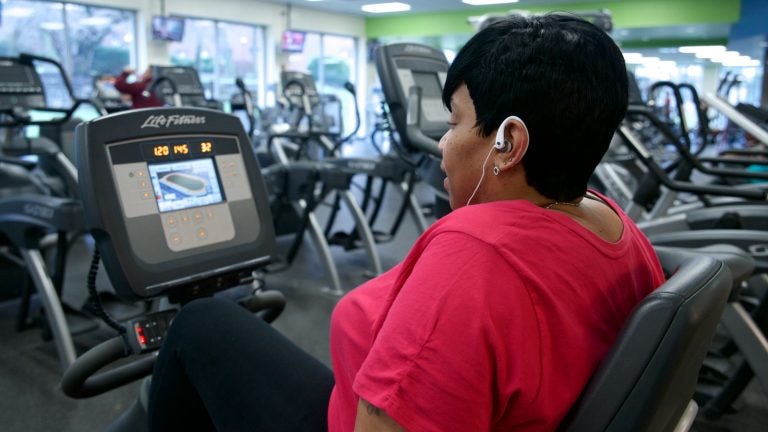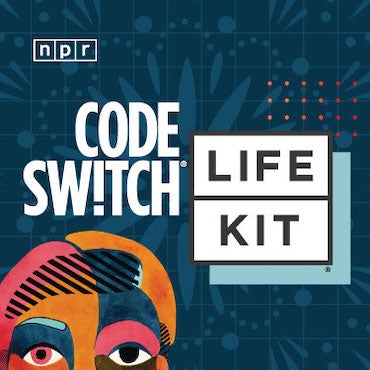Moving to the music: using science and sound to optimize your workout
Listen
Donna Williams listens to R&B hits at the Phila U. campus gym. The Phila U. employee visits gym three times a week. (Bastiaan Slabbers/for NewsWorks)
It’s the age of the super athlete. Everyone wants to be faster, better, stronger, and even those of us with zero Olympic aspirations want to get the most out of our workouts.
More and more research is looking into how music can optimize physical performance. And no one knows more about it than Dr. Costas Karageorghis, a professor of psychology at Brunel University in London. Dr. Karageorghis is one of the world’s leading experts on the effect music has on our bodies.
His passion for this field of research goes back to his childhood in South London, where he lived above a record store.
“So every morning, rather than being awoken by the sweet sound of bird song, or whatever, breaking gently through the curtains, there would be this thundering bass coming up through the floorboards,” he says. “And I recall as I used to get up and wipe my sleepy eyes and look out the window, I would notice that as people came within earshot of the music, their facial expressions would change, they would brighten up. Their gait would change, there would be a leap to it. The music seemed to provided an auditory backdrop to everything that happened in the locale.”
Observing the visible effects of music on people walking by led to Karageorghis’ lifelong passion of understanding how music helps us perform.
Scientific study into the field can be traced back to the early 20th Century, with one study done at a bicycle race at Madison Square Garden in New York. A band was playing at the race, and the researcher wanted to find out whether that might actually help the cyclists perform better.
“There was an ergogenic or a work-enhancing effect when the cyclists were engaged in the activity with the musical accompaniment,” says Dr. Karageorghis.
And that was no Beyonce tune–more likely a Sousa march.
So how is it that music can make us run faster, work out harder?
Well, Dr. Karageorghis says there are a few things going on. For one thing, music is a distraction. It takes our mind off of the stress we’re putting on our bodies.
“At least at low to moderate intensities of activity, music captures or blocks some of the messages that go from the working muscles and the organs to the brain so it can reduce perceived exertion and make us feel as though we are working less hard,” he says.
But there’s another more physical phenomenon. It’s called entrainment. That’s where we consciously try to synchronize our pace to the pace of the music.
It’s not clear why this happens, but brain scans show it’s located primarily in the cerebellum—sometimes called the reptilian brain. In other words, it’s old. Really old.
“If we look at our evolution, we think about how people attracted mates millennia ago. Much of that would have to do with rhythmic movement,” says Dr. Karageorghis. “And that’s something that has stayed with us through much of the evolution of man.”
And that hasn’t really gone away. A modern date night is still a trip to a dance club.
The idea here is that doing anything rhythmic, like running, cycling, or dancing, has its own intrinsic beat. The problem is our bodies have to maintain that beat. The right music essentially takes that effort partly off of our bodies. And Dr. Karageorghis research shows it has a real effect.
“The synchronization of body movements to a musical beat can result in about a seven percent reduction in oxygen uptake,” he says. “That is the amount of oxygen we use in a minute.”
That’s right, when we work out to music, we actually use less oxygen! Why?
Dr. Karageorghis offers an analogy. Imagine, he says, you were driving a car through a city and hit every green light. That would reduce the amount of fuel you needed. Being off pace with your movements is like hitting a red light. It uses energy because you have to accelerate to get back on pace or slow down if you’re going too fast.
How much of an effect can this have on performance? Enough that famed Ethiopian distance runner Haile Gebrselassie asked that his favorite music be played during a 5,000 meter run in Zurich in 1995. Dr. Karageorghis was there.
“He made an unusual request to the race organizers. He wanted them to play his favorite pop song, ‘Scatman’ by Scatman John during the race.”
The organizers agreed to the request, and running to that pace, Gebrselassie broke the 5,000 meter world record. When interviewed about why he played that music, Gebrselassie said the music fit his pace. He’d already used it in practice and knew if he could sync himself to that pace, he would break the record.
The phenomenon of entrainment goes far beyond athletics. DJs use it to keep people moving all night long.
“DJs have quite a strong baring on what people listen to. They are genuine thought leaders on the area of music and musical responses,” says Dr. Karageorghis. “When you talk to DJs and when you observe them, which I do a lot of, you’ll notice that a tempo of about 118 to 120 bpm is generally what will lure people onto the dance floor early on in the evening.”
But later in the night, when everyone is already on the floor and having a good time…
“That is when the tempo is going to be about in the 133, 140 bpm,” he says. “So there, you’re getting people really excited, aroused, activated, moving along in quite an animated way and having a good time.”
The principle of entrainment can be used not just to synchronize heartbeat, but to fool the body into working harder. When Dr. Karageorghis works with athletes, he assigns them workout music.
“I would typically use a music tempo that it is one or two beats per minute higher than an athletes desired strides per minute, he says. This will give the athlete a little push. It will make them run slightly faster. But the increase in effort will be imperceptible…if you try and bump it up by five or six or seven percent, its immediately perceptible and it will make the athlete feel uncomfortable and will not have the desired effect.”
Of course, not everyone has a sports scientist tracking their every workout. That’s where Shahriar Nirjon comes in. He’s a computer scientist at the University of North Carolina.
It was during graduate school that Nirjon came up with the idea of an app that could get information about the user’s heartrate.
“Our original idea was to use earphones, to add more sensors to earphones, so that we can use them for medical applications,” he says.
But he thought that technology could be used for exercise as well. So he created Musical Heart. It’s an app that, paired with a heart rate monitor, selects music that moves the user’s heart rate closer to a target, say 130 beats per minute. And the more it’s used, the more it learns what works for each individual.
“After listening to 100 songs, that model will be more personalized. It will represent you more than it was doing initially.”
There’s a third way that music affects our bodies. Something Dr. Karageorghis calls “extra musical association.” That’s where a piece of music is associated with a movie or a TV show–something many people are exposed to.
Think, for example, of the iconic music from “Chariots of Fire,” which doesn’t seem to fit any of the criteria of good workout music. Dr. Karageorghis agrees.
“This is a relatively slow tempo. It’s around resting heart rate. But because of those associations of athletes striving for Olympic glory, it brings out the hero in us and it makes us want to strive to be the very best that we can be.”
Shai Ben-Yaacov’s forthcoming podcast “The Playground,” is about how physical activity plays a role in our lives.
WHYY is your source for fact-based, in-depth journalism and information. As a nonprofit organization, we rely on financial support from readers like you. Please give today.

